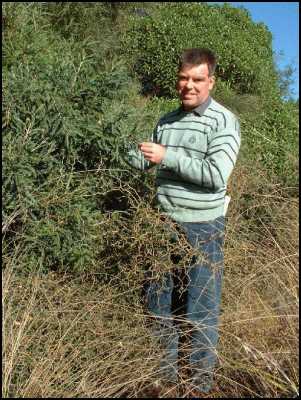Scientists Name Five New Species Of Kowhai

Landcare Research scientist Dr Peter Heenan with the shrub Sophora molloyi, one of five kowhai species newly named by Dr Heenan and Mr de Lange. The plant with zig-zag branches just below Sophora molloyi is Sophora prostrata, a prostrate kowhai.
It has mellow, yellow flowers which attract bevies of birds and insects, and most people know it simply as kowhai. But in a groundbreaking study, scientists from Landcare Research and the Department of Conservation have named five new species of the iconic native tree. They also say there is a strong conservation need to keep these separate.
Previously, scientists recognised just three species of kowhai in New Zealand. But Landcare Research plant taxonomist Dr Peter Heenan and Department of Conservation scientist Mr Peter de Lange say there are in fact eight. Their findings have just been published in the New Zealand Journal of Botany.
"Before our study, the only species recognised were Sophora tetraptera, a large leaved North Island tree, and Sophora prostrata, a small leaved South Island tree, which, as the name implies, often grows flat along the ground. Everything in between was thought to be the common Sophora microphylla, though botanists have struggled for 150 years to explain variations" says Dr Heenan.
"The research began with looking at Sophora longicarinata, which was published as a species in 1942, reduced to a variety of S.microphylla in 1961, and which we now recognise as a species again. It grows on marble and limestone, in north-west Nelson and western Marlborough".
"During this research it became apparent that there were other species that could not be explained away as variations of Sophora microphylla. These species have different growth habits, leaves, flowers and flowering times, as well as different habitats. We need to appreciate them all, and preserve their uniqueness".
The other new species of kowhai that Dr Heenan and Mr de Lange have named are:
Sophora godleyi, which grows on sandstone, siltstone and mudstone in areas including Rangitikei, Wanganui, Taihape and eastern Taranaki. It is named after Dr Eric Godley, who was the head of the former DSIR's Botany Division for 22 years, and worked on Sophora.
Sophora molloyi, a shrub with a very long flowering time. It grows on harsh and inhospitable sites on dry, exposed headlands around Cook Strait, Kapiti Island, and parts of the lower North Island. It is named after Dr Brian Molloy, a scientist and research associate for more than 30 years, who is well known in the fields of conservation, taxonomy, and plant ecology. As Dr Heenan puts it, this kowhai is "as tough as old boots", and, like its namesake Dr Molloy, it is hardy in all extremes of weather.
Sophora fulvida, which grows on basalt and other volcanic outcrops from Marlborough to Waikato, and has particularly hairy leaves.
Sophora chathamica, which grows mainly in western coastal areas of the northern North Island, and also around Wellington, and on the Chatham Islands. "We speculate that it does not occur naturally in Wellington and the Chathams, and that it was moved down there by Waikato and Taranaki Maori in the late 1700s and early 1800s" says Dr Heenan. "Kowhai are regarded by Maori as a taonga, a treasure".
Dr Heenan says the naming of the five new species of kowhai raises new biodiversity issues. "The main conservation implication is that people must become very, very conscious of the need to use local genetic material when they plant kowhai. That's not just to make sure the plants have the right climatic conditions to grow well. It's also to limit hybridisation, and keep the species separate.
"Most hybridisation is on disturbed sites, like lowland areas of the North Island, whereas on relatively intact sites, there is relatively little hybridisation".
"Also, many plants cultivated as Sophora microphylla are in fact a diverse mix of the newly named species and to a lesser extent Sophora prostrata and Sophora tetraptera as well. Many local authorities and members of the public are inadvertently mixing species distributions, and as the plants mature, the risk of hybridisation increases".
"The value of members of the public keeping the species separate and using the right kowhai in the right areas cannot be overstated".
ENDS


 University of Auckland: Protecting Young Minds With AI
University of Auckland: Protecting Young Minds With AI Greenpeace: Greenpeace Calls On Fonterra Investors To Consider Big Picture With Giant Puzzle
Greenpeace: Greenpeace Calls On Fonterra Investors To Consider Big Picture With Giant Puzzle Hugh Grant: How New Tech Helps Kids Love Soccer More
Hugh Grant: How New Tech Helps Kids Love Soccer More Bill Bennett: Download Weekly - 100% claim lands One New Zealand in criminal court action
Bill Bennett: Download Weekly - 100% claim lands One New Zealand in criminal court action FSCL: Woman Scammed Out Of $25,000 After Job Offer On LinkedIn
FSCL: Woman Scammed Out Of $25,000 After Job Offer On LinkedIn NIWA: Cheers To Crustaceans - New Species Named After Welly Brewery
NIWA: Cheers To Crustaceans - New Species Named After Welly Brewery



